Search the Special Collections and Archives Portal
Search Results
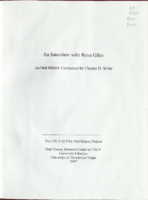
Transcript of interview with Reva Giles by Claytee D. White, July 17, 2006
Date
2006-07-17
Archival Collection
Description
Reva Giles grew up in the little town of New Carlisle, Indiana. She was one of twelve children, learning from an early age to share, to give and take, and to appreciate hand-me-downs. Her mother stayed home with the children, and her father worked for Studebaker, a large automobile manufacturer. Right after high school graduation, Reva moved to Redland, California, to live with a sister, working first at an ice cream place and then a bank. Reva married a military man, and she and their three sons followed him as he was transferred first to Las Vegas, then Okinawa, and finally Utah. When he retired in 1964, they returned to Las Vegas, where he went to work for Pete Findlay Oldsmobile. Their ' middle son Stuart played football at UNLV, and Reva got involved in fundraising and ticket sales for the team. Reva always enjoyed helping students, and from the ticket office she moved into admissions, and then student services. She worked for Drs. Ackerman and Burns helping to certify athletes, and from there went into career services, helping students find jobs and practice interview techniques. After Reva retired, Susie Smith asked her to come back and help, which Reva did gladly. She volunteers as an office aide to Susie as well as Mike Hamrick, athletic director at UNLV. Mike worked with Reva back in the eighties when he was a graduate student, and they have kept in touch through the years. Reva recalls the university campus when there were only two buildings, and was there for much of the new growth. She is familiar with the history of the Millennium Scholarship, the impact of Tarkanian's Runnin' Rebels on the community and school, and the North-South rivalry between UNLV and UNR's teams. Reva and her family have supported UNLV teams for many years, and she has many anecdotes concerning team trips.
Text
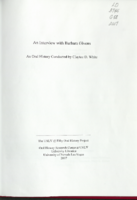
Transcript of interview with Barbara Givens by Claytee D. White, October 5, 2005
Date
2005-10-05
Archival Collection
Description
Barbara Givens was born in California, grew up in Reno, Nevada, and moved to Las Vegas in 1952 with her family when she was 14 years old. Her father ran a small construction business here in Vegas until he retired about 15 years ago. Her brother Steve and his children live in Vegas also. Barbara graduated from Las Vegas High School and enrolled in the first matriculated teacher's program at the Southern Regional Division of the University of Nevada at Las Vegas (now known as UNLV). Barbara was involved in organizing the first "Rebel Yell", school dances in Las Vegas, and other collegiate activities in Reno. In her senior year, she returned to Las Vegas High to complete her student teaching. After graduation, Barbara was assigned to Rancho High School to teach biology. She left after a year and a half because she had married and was expecting her first child. At that point in time, Clark County School District did not allow pregnant women to remain in the classroom. Fifteen years later she returned to the classroom, this time at Chaparral High. Concurrently, Barbara entered the Master's in Education program at UNLV, and graduated in 1980. Barbara has always loved to travel and has experienced many wonderful trips to exotic places around the world. In retirement, she assists with special events at Hamm Hall and Judy Bailey Theater, goes on-line to offer her services as a biology tutor to high school students, and continues to plan exciting trips abroad. She also indulges in her favorite hobby - attending Star Trek conventions and collecting Star Trek memorabilia.
Text
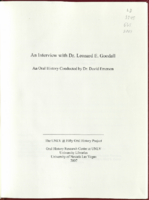
Transcript of interview with Dr. Leonard Goodall by Dr. David Emerson, March 28, 2006
Date
2006-03-28
Archival Collection
Description
Dr Leonard Goodall, former president of UNLV, comes from a unique educational background. He was born in Warrensburg, Missouri, a small town of only 6,000 souls, and received 12 years of education in the same building. After high school, he attended Central Missouri State College, which was only about 2 miles from his home. Dr. Goodall earned his master's degree at the University of Missouri, and attended the University of Illinois for his doctorate in political science. He went right into academic life, accepting a job at Arizona State in Tempe on the basis of a phone call. For five years he taught in the department of Political Science and conducted research at the institute. He subsequently moved to the University of Illinois Chicago as instructor and then chancellor (four years), and from there to the University of Michigan Dearborn as chancellor (eight years). In 1979, Leonard accepted a position as president of UNLV. He oversaw the development of the College of Engineering, helped create the UNLV Foundation, and made a number of appointments, such as athletic director, any number of deanships, and academic vice president of student affairs. After his presidency, Dr. Goodall returned to his professorship in public administration and served on many campus committees. He phased his retirement over several years, and was completely out in 2002. Today, Leonard continues to serve on graduate committees for UNLV, and works on the search committee to find a new president.
Text
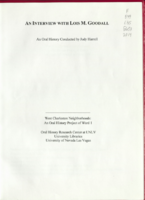
Transcript of Lois M. Goodall by Judy Harrell, November 12, 2013
Date
2013-11-12
Archival Collection
Description
Lois Goodall, wife of the fourth president of UNLV, Dr. Pat Goodall, speaks with pride when recalling her early life, marriage, and involvement with the University of Nevada, Las Vegas. She grew up in Odessa, Missouri, with a father who was a farmer and a teacher mother, went to college to become a teacher, and her freshman year met a young sophomore gentleman by the name of Pat Goodall. They married and while Pat attended graduate school at the University of Missouri, she taught fifth grade. After Pat earned his Ph.D. they moved to Arizona State University, where he taught political science, and then to the University of Illinois, the University of Michigan, and finally to UNLV. Lois, as the president's wife, enjoyed hosting various celebrities and faculty, was responsible for raising three children, and, miraculously, found time to earn her Master of Education degree in reading education and curriculum. She received her Master's hood from her husband, the president of the university, at her graduation. Expressing enthusiasm, Lois Goodall shows great delight in UNLV's growth and development. The university's Hotel Administration is second to none, and subsequent programs such as the addition of a law school imply maturity and expansion. She also admires the generosity and far sightedness of such individuals as Jerry Mack and Parry Thomas who not only funded the Thomas & Mack Center but purchased surrounding land so that the university could expand economically. Marjorie Barrick, another philanthropist, gave money for lectures benefiting faculty, students and community and also established the Barrick Scholar Award for students and Distinguished Scholar Award for faculty. As she describes the university's development, it is obvious that Lois Goodall remains one of UNLV's greatest supporters.
Text

Transcript of interview with Robert Gore by David Emerson, January 31, 2008
Date
2008-01-31
Archival Collection
Description
Robert Gore first came to Las Vegas in 1973 as a public affairs officer with the Air Force. He returned to West Virginia to go into the family business in 1976 and four years later was offered a job with Summa Corporation. Back in Las Vegas, he also served as director of the Air Force Association. At a dinner meeting of the Association, Retired General Bill Becker suggested that an engineering school was needed at UNLV. Bob and the Air Force Association put together a group called FORGE, whose primary purpose was to promote a school of engineering. Bob Gore, Dave Broxterman, John Heilman and others began researching the idea of building an engineering school. They drew the interest of people at the Test Site, Nellis Air Force Base, and PEPCON, and put together a slide show and a binder full of research data. Bob and Dave presented their information to the Nevada Development Authority and Nevada legislators, and started a grassroots campaign to enlist the support of the people of Nevada. Bob gives details on the efforts that FORGE and many other individuals made on behalf of the engineering school. He takes readers into the myriad meetings that were held and the important associations that were forged with people like Tom Beam Lawrence Livermore Laboratories, the DOE, Jim Cashman, Mary Hausch of the Las Vegas Review Journal, Channel 3, Bob Thomas, and numerous others. The interviewer, Dr. David Emerson, was involved in this effort as well, and shares anecdotes concerning donations from a mining company and Reynolds Electrical and Engineering Company. Today Bob is working with a real estate company in Las Vegas. Twenty-some years later, he still recalls the hard work and dedication of people like Benet Stout, on loan from Senator Chic Hecht's staff, the legislators who unanimously cosponsored the bill initiating the building project, and the original FORGE group who gave their all to the idea of a school of engineering at UNLV.
Text
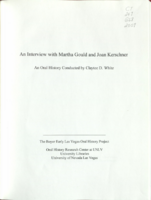
Transcript of interview with Martha Goulda and Joan Kerschner by Claytee D. White, October 26, 2005
Date
2005-10-26
Archival Collection
Description
Martha Gould and Joan Kerschner have been instrumental in most phases of library development in Nevada - from the branch to the state library. Their stories are fascinating and cover the techniques of moving a physical library to installing massive computer systems. They became librarians as young women and worked their entire careers in the field. Their memories add depth and profound meaning to the work of librarians. Gould grew up in a small mill town on the Sugar River and attended the University of Michigan. A librarian at Dartmouth College gave her a job and then insisted that she return to school for a master's degree. She earned her MS in Library Science from Simmons College. Kerschner hails from the Midwest, growing up in Abe Lincoln country. As a young girl, she went into their little Carnegie Library to rest and to view photographs on the stereograph while in town shopping with her family. She attended college across the river at Kentucky Wesleyan College and then earned a master's in library science at Indiana University. Martha and Joan have lobbied and testified before assembly committees to help bring libraries in Nevada to their current standing. This interview is about serious work told by two women, one who became state librarian, who look back over their many accomplishments with laughter and great joy.
Text
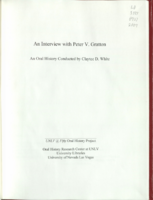
Transcript of interview with Peter Gratton by Clayee D. White, February 26, 2009
Date
2009-02-26
Archival Collection
Description
Peter Gratton was born in 1944 in Staten Island, New York, where his father was in the Coast Guard. However, he spent his childhood in Minnesota. From 1965 to 1969, Peter was a member of the US Marine Corps, serving a tour in Vietnam. As his military duty was ending, he learned that his parents were relocating to Vegas, bringing with them all of Peter's belongings. So Peter caught up with them in Vegas where he transitioned to civilian life in a new city by "bumming around for a couple of months." He decided to stay and took a keno job at Golden Gate Casino. In 1981, he graduated from UNLV and was accredit to teach history and earth science. This proved to be a good background for an opening at the UNLV library and he helped organize the map collection. With that, his UNLV library career was successfully launched. At the time of this interview, Peter was Administrative Assistant III Lied Library Building Department. In the following pages Peter tells of his experiences that lead up to becoming a Las Vegas resident and longtime member of the UNLV library staff.
Text
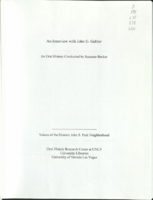
Transcript of interview with John G. Gubler by Suzanne Becker, December 29, 2008
Date
2008-12-29
Archival Collection
Description
When John Gubler's parents moved to Las Vegas in 1936, it was a simple desert community of only six or seven thousand people. John's father practiced law and his mother raised the four Gubler sons. Home was in the John S. Park area. It was a fenceless neighborhood where everyone knew each other. Parents worked hard at their various jobs and kids played on the barren stretches of desert shooting BB guns, exploring artesian wells and playing games. As the gaming industry and the city grew, the Gubler household focused on education and family. It was a life of freedom and no TV. They were a family raised in Mormon values. John went on to become a lawyer and move back to raise his own family here. Today he lives on the western side of the valley. He explains that as an adult when he drives through John S. Park Neighborhood, "I live in the past." It was a good life. As John reminiscences about growing up from the 1940s thru 1960s, his observations are vivid and range from local
Text
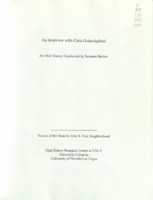
Transcript of interview with Chris Guinchigliani by Suzanne Becker, July 20, 2007
Date
2007-07-20
Archival Collection
Description
Three decades prior to this interview, Chris Guinchigliani moved to Las Vegas and began teaching at the Clark County School District. Seeing Las Vegas as a place of personal opportunity, she involved herself first in the teachers union; eventually serving as president of the Nevada State Education Association from 1987 through 1991. She shares some of her political experiences being elected to the Nevada State Assembly for 16 years and then became a Clark County Commissioner. Chris and her husband Gary Gray (above left) are longtime residents of the John S. Park Neighborhood and Chris was among those who originated the idea to getting a historical designation for the community. She highlights the process and obstacles within the community as people developed an understanding about what preservation really meant. She touches upon a broad range of topics that living in the neighborhood: Manhattanization, increased traffic, crime, lack of amenities such as a grocery store, the
Text
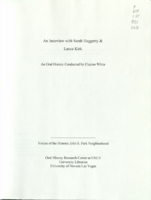
Transcript of interview with Sarah Haggerty and Lancy Kirk by Claytee D. White, February 2, 2010
Date
2010-02-02
Archival Collection
Description
Sarah Haggerty and Lance Kirk are a married couple with two small children. Both are born and raised Nevadans—he's from Reno and she's from Las Vegas. Sarah has deeply rooted memories of the John S. Park area, her paternal grandparents' home is there. As a couple, Sarah and Lance reflect on home ownership in both the Huntridge and John S. Park areas. Lance, an architect, talks about the house and the social communities. And ultimately asks the poignant question: Is the community making us or are we making the community? Sarah reminisces about the transition in the neighborhood, a transition that she feels began in the 1990s as the original owners aged and their homes were sold to a new generation of owners at a time when the greatest growth in the valley was to the suburbs. She may harbor nostalgic feelings, but she is also a realist: It's just different. We face different challenges but we have different rewards too, she says.. Among the most significant changes is the increased Hispanic demographic, which she guesses to be nearly 50%. They talk about the challenge of getting these residents more involved in the community's social and activist causes. About crime, they observe that is isn't necessarily higher, but it is affected by the homeless population that gravitates there. Their wish list includes: sidewalks, parks, community centers, more restaurants. However, none of this discourages their love of living in John S. Park. They have been actively involved in projects that draw the community together, from door knocking to using social networking to assist those efforts.
Text
Pagination
Refine my results
Content Type
Creator or Contributor
Subject
Archival Collection
Digital Project
Resource Type
Year
Material Type
Place
Language
Records Classification
